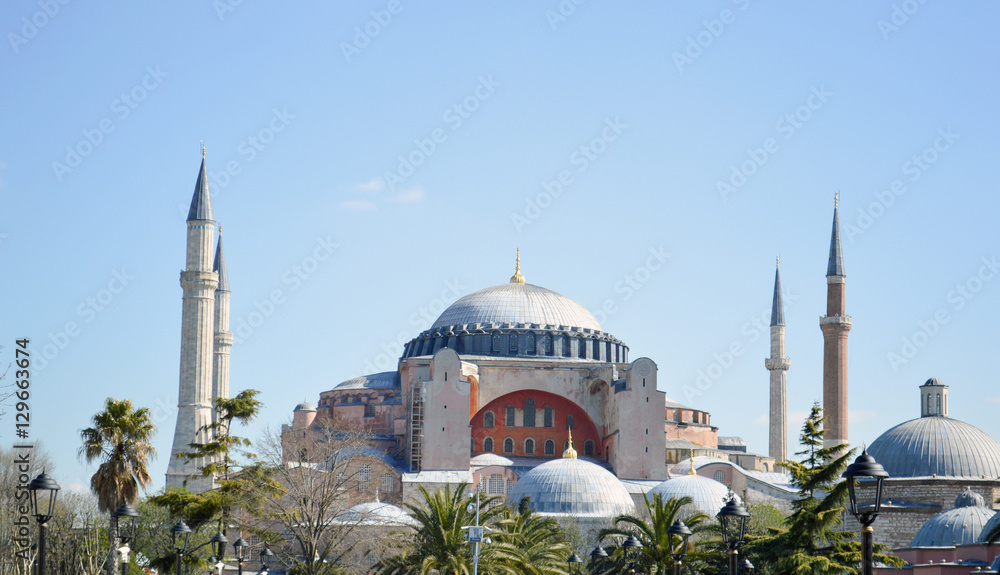Hagia Sophia: Architectural Marvel Across Empires

Table of Contents
A Byzantine Masterpiece: The Original Hagia Sophia (532-1453)
Innovative Dome Construction
The Hagia Sophia's most striking feature is its massive dome, a revolutionary feat of engineering for its time. The architects, Anthemius of Tralles and Isidore of Miletus, ingeniously employed pendentives – triangular sections of masonry – to transition the circular dome onto a square base. This innovative solution allowed for a vast, light-filled interior space unlike any seen before. The dome's sheer size, approximately 31 meters in diameter and 55 meters high, was awe-inspiring, dwarfing contemporary structures.
- Engineering Challenges and Solutions: Constructing such a massive dome presented immense engineering challenges, requiring precise calculations and innovative techniques in brick and mortar construction. The architects cleverly used lightweight materials and carefully distributed the weight to prevent collapse.
- Comparison to Other Structures: Compared to Roman structures reliant on massive barrel vaults, the Hagia Sophia's dome showcased a more elegant and sophisticated approach, paving the way for future architectural advancements.
- Materials and Visual Impact: The dome's construction utilized brick and mortar, creating a surprisingly lightweight yet strong structure. The enormous size and airy feel of the dome created a sense of grandeur and spiritual upliftment, flooding the interior with natural light.
Interior Splendor and Mosaics
Beyond the dome, the Hagia Sophia's interior was a breathtaking display of Byzantine artistry. Lavish use of gold, marble, and other precious materials created a dazzling effect, enhanced by the intricate mosaics adorning the walls and vaults. These mosaics, depicting emperors, saints, and biblical scenes, are of immense artistic and religious significance.
- Use of Precious Materials: The interior shimmered with gold leaf, coloured marbles, and intricate patterns, reflecting the wealth and power of the Byzantine Empire.
- Depiction of Emperors, Saints, and Biblical Scenes: The mosaics provided a visual narrative of religious and imperial history, conveying theological concepts and celebrating imperial power.
- Impact of Iconoclasm: Periods of iconoclasm – the destruction of religious images – significantly impacted the mosaics. Many were destroyed or covered over, only to be rediscovered and restored in later centuries. The surviving mosaics offer glimpses into the artistic styles and theological debates of different eras.
- Ongoing Restoration Efforts: The ongoing conservation and restoration of these priceless mosaics are crucial for preserving a vital part of Byzantine artistic heritage and understanding the Hagia Sophia's rich past.
Transformation into a Mosque: The Ottoman Era (1453-1931)
Architectural Adaptations
After the Ottoman conquest of Constantinople in 1453, the Hagia Sophia was transformed into a mosque, reflecting the changing religious and cultural landscape. Several architectural additions were made to accommodate Islamic worship practices.
- Addition of Minarets: Four elegant minarets, slender towers from which the call to prayer (adhan) is made, were added to the exterior, becoming iconic symbols of the Hagia Sophia's transformation. Their architectural style reflects the Ottoman period.
- Mihrab and Other Islamic Features: A mihrab (a niche indicating the direction of Mecca) was added to the interior, along with a mimbar (pulpit) and other elements essential for Muslim prayer. The addition of these features integrated Islamic practices into the existing structure.
- Covering of Mosaics: Many of the Byzantine mosaics were covered with plaster or other materials to conform to Islamic iconoclastic traditions which prohibited the depiction of living beings.
Ottoman Influence and Patronage
Ottoman sultans played a crucial role in maintaining and enhancing the Hagia Sophia, demonstrating their power and piety. They oversaw extensive repairs and renovations, ensuring the structure’s longevity.
- Key Sultans and Their Contributions: Sultans like Mehmed II, the conqueror of Constantinople, and subsequent rulers, invested significant resources in maintaining and embellishing the Hagia Sophia.
- Use of Calligraphy and Islamic Art Forms: Islamic calligraphy and other art forms were incorporated into the interior, further reflecting the Ottoman period’s aesthetic sensibilities.
- Maintenance and Repairs: The Ottomans carried out extensive repairs and maintenance over the centuries, ensuring the Hagia Sophia remained a structurally sound and aesthetically impressive building.
- Symbol of Ottoman Power and Piety: The Hagia Sophia's continued use as a major mosque served as a powerful symbol of Ottoman power and religious devotion.
Museum and Beyond: The 20th and 21st Centuries (1931-Present)
Secularization and Museum Status
In 1931, under the Turkish Republic, the Hagia Sophia was secularized and converted into a museum. This decision opened a new chapter in the building's history.
- Process of Secularization: The conversion into a museum reflected the Turkish Republic's efforts to establish a secular state.
- Revealing of Mosaics: The covering of the mosaics was removed during the museum’s establishment, allowing the stunning Byzantine art to be appreciated once again.
- Major Tourist Attraction: The Hagia Sophia became one of Turkey's most significant tourist attractions, drawing millions of visitors annually. Its global significance as a cultural landmark cemented its status in the modern world.
Recent Developments and Ongoing Debate
The 2020 decision to convert the Hagia Sophia back into a mosque sparked international debate.
- Legal and Political Aspects: The legal basis and political motivations behind this decision were subject to extensive discussion and criticism.
- Responses from Religious and Cultural Groups: The decision elicited various responses from religious and cultural groups worldwide, highlighting the building's enduring religious and cultural significance.
- Future of the Hagia Sophia: The ongoing debate about the Hagia Sophia's future underscores the complex interplay of religious, cultural, and political forces surrounding this iconic monument. The balance between religious observance and accessibility for visitors remains a key consideration.
Conclusion
The Hagia Sophia's journey across centuries and empires showcases not only remarkable architectural innovation but also the dynamic interplay of cultures and religions. From its Byzantine origins as a grand cathedral to its transformation into a mosque and its current status as a place of worship, the Hagia Sophia's story remains a captivating narrative of human achievement and enduring faith. To further explore the rich history and architectural brilliance of this iconic structure, delve deeper into the numerous books and documentaries available about the Hagia Sophia. Understanding its evolution helps us appreciate its enduring legacy as a true architectural marvel across empires.

Featured Posts
-
 La Wildfires A Reflection Of Our Times Through Disaster Betting
Apr 29, 2025
La Wildfires A Reflection Of Our Times Through Disaster Betting
Apr 29, 2025 -
 Trumps Potential Pardon Of Pete Rose A Look At The Mlb Betting Ban
Apr 29, 2025
Trumps Potential Pardon Of Pete Rose A Look At The Mlb Betting Ban
Apr 29, 2025 -
 Hollywood And Football Ryan Reynolds On Wrexhams League Return
Apr 29, 2025
Hollywood And Football Ryan Reynolds On Wrexhams League Return
Apr 29, 2025 -
 Nyt Spelling Bee Answers February 10 2025 Find The Pangram
Apr 29, 2025
Nyt Spelling Bee Answers February 10 2025 Find The Pangram
Apr 29, 2025 -
 Why All American Production Remains A Challenge
Apr 29, 2025
Why All American Production Remains A Challenge
Apr 29, 2025
Latest Posts
-
 Tremor 2 Netflix Series Kevin Bacons Potential Return Explored
Apr 29, 2025
Tremor 2 Netflix Series Kevin Bacons Potential Return Explored
Apr 29, 2025 -
 A Tremors Series For Netflix What We Know So Far
Apr 29, 2025
A Tremors Series For Netflix What We Know So Far
Apr 29, 2025 -
 Is Tremors Returning To Netflix Updates And Rumors
Apr 29, 2025
Is Tremors Returning To Netflix Updates And Rumors
Apr 29, 2025 -
 Tremor 2 Will Kevin Bacon Return In The New Netflix Series
Apr 29, 2025
Tremor 2 Will Kevin Bacon Return In The New Netflix Series
Apr 29, 2025 -
 Netflix Tremors Series Release Date Cast And Plot Speculation
Apr 29, 2025
Netflix Tremors Series Release Date Cast And Plot Speculation
Apr 29, 2025
